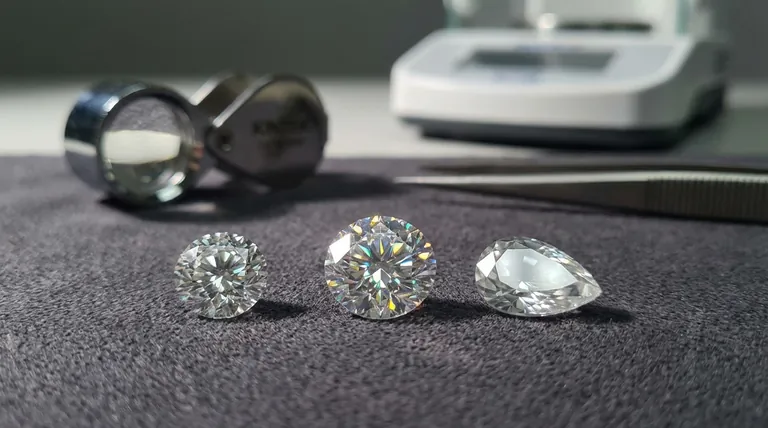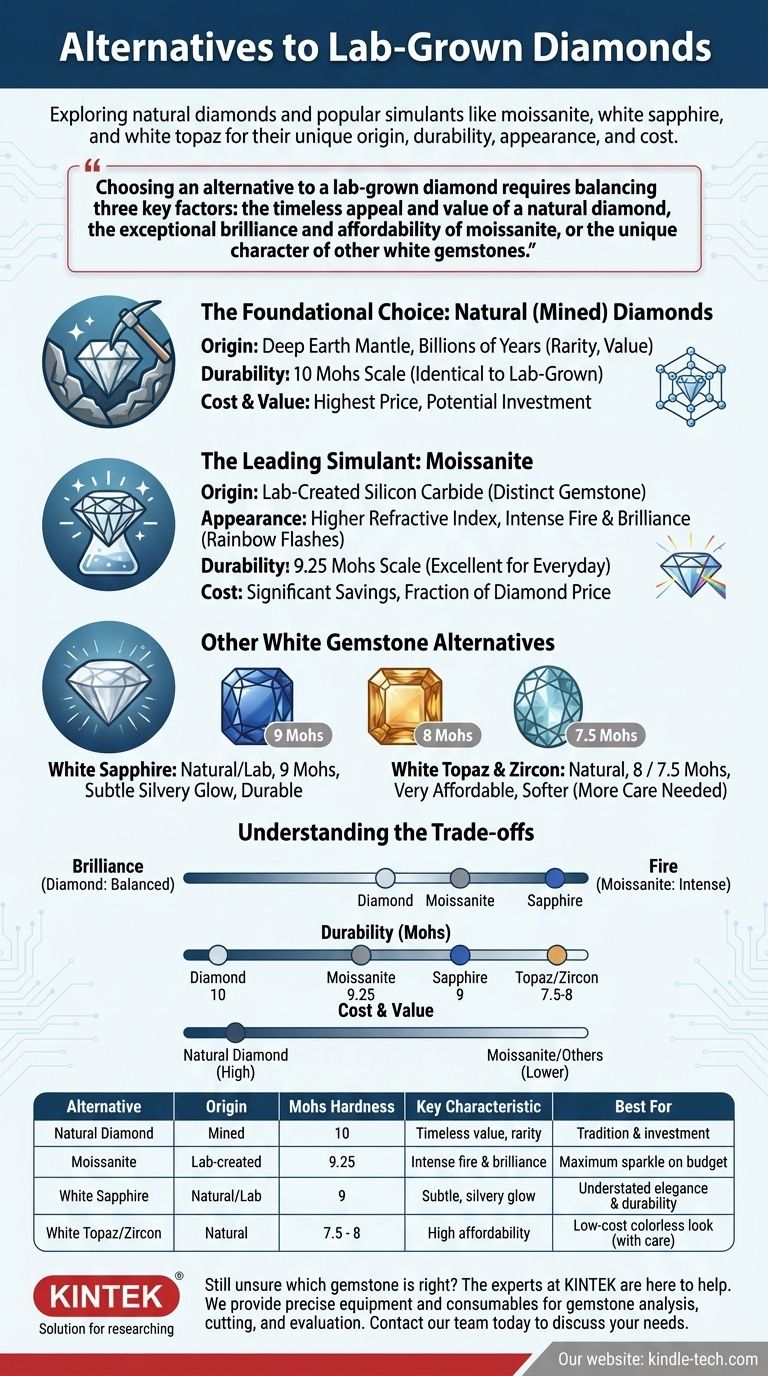The primary alternatives to lab-grown diamonds are natural (mined) diamonds and diamond simulants. The most popular simulants that offer a similar look include moissanite, white sapphire, and white topaz. Each of these options presents a distinct combination of origin, durability, appearance, and cost.
Choosing an alternative to a lab-grown diamond requires balancing three key factors: the timeless appeal and value of a natural diamond, the exceptional brilliance and affordability of moissanite, or the unique character of other white gemstones.

The Foundational Choice: Natural (Mined) Diamonds
For many, the most direct alternative to a lab-grown diamond is one that formed naturally within the Earth. While chemically identical, their origin stories are fundamentally different.
### The Allure of Rarity and Origin
A natural diamond is the product of immense pressure and heat deep within the Earth's mantle over billions of years. This ancient origin story and inherent rarity are a primary driver of its value and symbolic meaning.
### Identical Physical Properties
Optically, chemically, and physically, a natural diamond is identical to its lab-grown counterpart. Both are pure carbon, and both score a 10 on the Mohs scale of hardness, making them the most durable gemstone.
### The Value and Cost Distinction
The significant difference lies in cost and long-term value. Due to a finite supply and the expense of mining, natural diamonds command a much higher price. Historically, they have also retained more resale value compared to man-made alternatives.
The Leading Simulant: Moissanite
Moissanite is not a synthetic diamond; it is a distinct, lab-created gemstone (silicon carbide) that has become the most popular diamond alternative for its unique visual properties and durability.
### Unmatched Brilliance and Fire
Moissanite has a higher refractive index than a diamond. This results in more "fire," or flashes of rainbow-colored light. This intense sparkle is a key characteristic that some people prefer, while others may find it looks different from a diamond's more balanced white and colored light return.
### Excellent Durability
With a hardness of 9.25 on the Mohs scale, moissanite is second only to diamond. This makes it exceptionally resistant to scratching and an excellent choice for everyday wear in pieces like engagement rings.
### Significant Cost Savings
Moissanite offers a diamond-like appearance at a small fraction of the cost of both natural and lab-grown diamonds of a similar size and quality.
Other White Gemstone Alternatives
If you are open to a stone that is not a diamond or a direct simulant, several other natural gemstones offer a beautiful white or colorless appearance.
### White Sapphire
A sapphire is a classic and durable choice, rating a 9 on the Mohs scale. Unlike the fiery sparkle of a diamond or moissanite, white sapphire has a more subtle, silvery-white brilliance. It provides an elegant, understated look but requires more frequent cleaning to maintain its shine.
### White Topaz and White Zircon
These gemstones are very affordable alternatives for achieving a colorless look. However, they are significantly softer, with topaz at an 8 and zircon at a 7.5 on the Mohs scale. This makes them much more susceptible to scratches and damage with daily wear.
Understanding the Trade-offs
Choosing the right stone is about understanding what you gain and what you give up with each option.
### Appearance: Brilliance vs. Fire
A diamond (natural or lab) offers a balanced return of white light (brilliance) and colored light (fire). Moissanite is defined by its intense, rainbow-like fire. White sapphire provides a softer, more silvery glow with less sparkle.
### Durability for Everyday Wear
For a ring worn daily, durability is critical. Diamond (10) and moissanite (9.25) are the top choices and will resist scratches for a lifetime. Sapphire (9) is also very durable, while topaz (8) and other softer gems require more care and may become abraded over time.
### Cost and Long-Term Value
Natural diamonds are the most expensive but have the strongest history of retaining value. Lab-grown diamonds and moissanite offer immense visual impact for their price but are not considered financial investments. Other gemstones vary but are almost always more affordable than natural diamonds.
Making the Right Choice for Your Goal
Your personal priority should guide your decision.
- If your primary focus is tradition and long-term value: A natural diamond is the unparalleled choice.
- If your primary focus is maximizing size and sparkle for your budget: Moissanite offers the most brilliance and durability for its cost.
- If your primary focus is a durable, natural gem with a subtle look: White sapphire is an elegant and classic alternative.
- If your primary focus is the lowest possible cost for a clear stone: White topaz or zircon can work, with the understanding they require careful handling.
Ultimately, the best alternative is the one that aligns perfectly with your personal values, aesthetic taste, and budget.
Summary Table:
| Alternative | Origin | Mohs Hardness | Key Characteristic | Best For |
|---|---|---|---|---|
| Natural Diamond | Mined from Earth | 10 | Timeless value, rarity | Tradition & long-term investment |
| Moissanite | Lab-created (silicon carbide) | 9.25 | Intense fire & brilliance | Maximum sparkle on a budget |
| White Sapphire | Natural or lab-created | 9 | Subtle, silvery glow | Understated elegance & durability |
| White Topaz/Zircon | Natural | 7.5 - 8 | High affordability | Low-cost colorless look (with care) |
Still unsure which gemstone is right for your application? The experts at KINTEK are here to help. Whether you're outfitting a research lab, a jewelry workshop, or a quality control facility, we provide the precise equipment and consumables needed to analyze, cut, and evaluate gemstones and materials.
We serve professionals who require accuracy and reliability. Contact our team today to discuss your specific needs and find the perfect solution for your project.
Visual Guide

Related Products
- Cylindrical Resonator MPCVD Machine System Reactor for Microwave Plasma Chemical Vapor Deposition and Lab Diamond Growth
- CVD Diamond Cutting Tool Blanks for Precision Machining
- Metallographic Specimen Mounting Machine for Laboratory Materials and Analysis
- CVD Diamond Domes for Industrial and Scientific Applications
- Custom PTFE Teflon Parts Manufacturer for PTFE Buchner Funnel and Triangular Funnel
People Also Ask
- What are the limitations of diamonds? Beyond the Myth of Perfection
- What machine is used to make lab-grown diamonds? Discover the HPHT & CVD Technologies
- How to start a lab grown diamond business? Choose the Right Model for Success
- What is the difference between MPCVD and HFCVD? Choose the Right CVD Method for Your Application
- What are the applications of microwave plasma? From Diamond Synthesis to Semiconductor Fabrication











